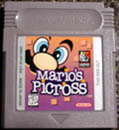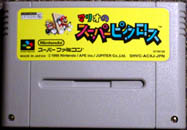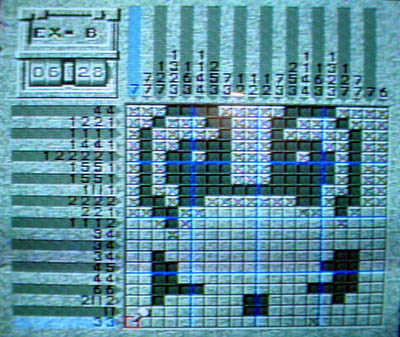I Finally Did it!
I've been playing The import of Mario's Super Picross for the Super Famicom around twice a week for almost a year. Ever since I got back from Japan it hasn't left my SNES, and I'm proud to say that earlier this week I finally beat it by making it through the last couple of puzzles in a series of exactly 300! This is a huge accomplishment for me, as I usually play a game for a week and then throw it into the collection and almost never play it again. There's something about the simple and rewarding nature of Picross that kept me coming back to it though.

My first experience with Mario's Picross was with the little-known game boy version that was released in the US in March of 1995. This was a great game, but a fairly short-lived experience (only 198 puzzles). I actually had assumed that no sequel had been made until I ran across a boxed copy of Mario's Super Picross in a Japanese game store located above a bait and tackle shop in Sendai City, Japan.


Picross strikes me as the type of puzzle game that you might find in the back of a newspaper. It's one of those games that some people will understand immediately and others will just never "get". The playing field is essentially an empty grid with a series of numbers located to the left of each row and above each column. The numbers are used to tell how many of the corresponding row or column's boxes to fill in. For example, if you find a number 10 next to a row of ten squares, you would know to fill in all ten. Most rows/columns will have more than one number in them though. Let's say a row of 10 boxes has the numbers four and five next to it, you would fill in four squares, skip one, and fill in the 5 remaining because 4 filled + 1 blank + 5 filled = 10 boxes. It gets more complicated when you have things like a row of ten squares with a 1 next to it because the 1 could be in any row at all. In this case you won't know what to fill in unless you have used the vertical column as well. Once you've filled in all of the correct squares a picture will be constructed that then animates with a little 2 frame animation. That's the basic jist of the game, and if the description is confusing or makes the game sound boring than just take my word for it. Picross is a blast!

If you do a google search you can find playable versions of Picross on the internet, but, like so many other amature remakes, they are usually missing some vital part that makes the game fun. The puzzles in Mario's Picross are all meticulously planned out to only have one possible solution. Just drawing a picture on a grid won't necessarily create a good Picross puzzle. They must follow a certain algorithm that I haven't personally tried to figure out, but Nintendo obviously used it when creating the puzzles. The puzzles are also paced perfectly so that they start out easy and become increasingly difficult, without piling on overly difficult ones near the end. If you can track down a copy of Mario's Picross for the Game Boy or import a copy of the Super Famicom sequel, you won't be disappointed. With any luck, Nintendo will see how perfect Picross translates to a touch screen and will bring it out for the DS. If this happens, I may finally have another game that can keep my attention for a whole year!
-Wes
|




